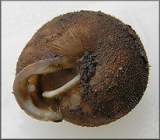Adaptation
As one should know, being small and living in a large habitat with many predators requires protecting ones self; if you don't you could potentially be eaten. With Inflectarius smithi being a part of the Phylum Mollusca, it has a notable calcium carbonate shell that it uses for protecting its softer tissues. As you read from the Habitat page, Inflectarius smithi lives in calcium rich areas to develop its shell as it grows. To aid in protecting its softer body, when attacked by a predator, the snail pulls its body inward into the shell, closing off the entrance with a plug called an operculum or a mucus barrier; these are also used to seal in moisture.
Inflectarius smithi are relatively small. Henry Pilsbry quotes G. H. Clapp that, on average, they are around 15 mm in length (Pilsbry, 1940). When one looks closely at an uninhabited Inflectarius smithi shell, one can see there are periostracal hairs that cover the entire outside of the shell (Auffenberg et al, 1989). In a sense the development of these spiky hairs makes Inflectarius smithi a little more unpleasant to try to eat. Also, Henry Pilsbry quotes from H.H. Smith that Inflectarius smithi are covered with dark soil that gets stuck in the hairs on the shell as it buries itself, as you see the remnants of on in the above picture (Pilsbry, 1940). Burying itself makes it even harder for their predators to locate them, and it also helps to retain moisture.
Interesting Fact: Dr. Perez states that most snails that you find buried in dirt and leaf litter on the forest floor have periostracal hairs on their shells.
Around the opening of the shell there is a thick basal lip with a well developed parietal tooth and a small palatal tooth (Auffenberg et al, 1989). These structures are designed to shrink the size of the opening to increase the difficulty of predators eating the snail, along with providing more surfaces for the mucus to form a protective plug.
Being a Gastropod, Inflectarius smithi has a muscular "foot" on its belly, which is what Gastropod stands for "belly foot." They use this muscular foot to move slowly about their habitats, secreting a mucus to help adhere and slide along the terrain better (Encyclopedia of Life, 2012). Pilsbry quotes Dr. Archer in the fact that Inflectarius smithi are almost always active after dark, where most day-time predators would be sleeping, thus making it safer to find food and mates (Pilsbry, 1940).
One thing that you cannot tell by just looking at Inflectarius smithi, is since it is a terrestrial Gastropod, it developed its mantle cavity to house an air-breathing lung (Eisenhour et al, 2009).
The eyes located at the ends of the uppermost pair of a set of four tentacles, is something unique to land snails (The Poweshiek Skipper Project, 2007). Having a pair of eyes that can move around and high above the body allows the snail to see around itself much better than a pair of fixated eyes attached to the head.
To see the references for the cited information provided in this website, got to the References page. To learn more about me or how to contact me for questions or comments, go to the About Me page.
